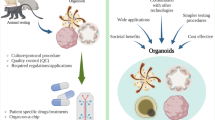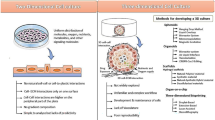Abstract
Introduction
Two main approaches (organ culture and hypothermia) for the preservation and storage of human donor corneas are globally adopted for corneal preservation before the transplant. Hypothermia is a hypothermic storage which slows down cellular metabolism while organ culture, a corneal culture performed at 28–37 °C, maintains an active corneal metabolism. Researchers, till now, have just studied the impact of organ culture on human cornea after manipulating and disrupting tissues.
Objectives
The aim of the current work was to optimize an analytical procedure which can be useful for discovering biomarkers capable of predicting tissue health status. For the first time, this research proposed a preliminary metabolomics study on medium for organ culture without manipulating and disrupting the valuable human tissues which could be still used for transplantation.
Methods
In particular, the present research proposed a method for investigating changes in the medium, over a storage period of 20 days, in presence and absence of a human donor cornea. An untargeted metabolomics approach using UHPLC-QTOF was developed to deeply investigate the differences on metabolites and metabolic pathways and the influence of the presence of the cornea inside the medium.
Results
Differences in the expression of some compounds emerged from this preliminary metabolomics approach, in particular in medium maintained for 10 and 20 days in presence but also in the absence of cornea. A total of 173 metabolites have been annotated and 36 pathways were enriched by pathway analysis.
Conclusion
The results revealed a valuable untargeted metabolomics approach which can be applied in organ culture metabolomics.




Similar content being viewed by others
Data availability
No datasets were generated or analysed during the current study.
References
Akram, M. (2014). Citric acid cycle and role of its intermediates in metabolism. Cell biochemistry and biophysics, 68(3), 475–478.
Armitage, W. J. (2011). Preservation of human cornea. Transfusion Medicine and Hemotherapy, 38(2), 143–147.
Benavente, M. C. R., & Argüeso, P. (2018). Glycosylation pathways at the ocular surface. Biochemical Society Transactions, 46(2), 343.
Borderie, V. M., Baudrimont, M., Lopez, M., Carvajal, S., & Laroche, L. (1997). Evaluation of the deswelling period in dextran-containing medium after corneal organ culture. Cornea, 16(2), 215–223.
Bucolo, C., Maugeri, G., Giunta, S., D’Agata, V., Drago, F., & Romano, G. L. (2023). Corneal wound healing and nerve regeneration by novel ophthalmic formulations based on cross-linked sodium hyaluronate, taurine, vitamin B6, and vitamin B12. Frontiers in Pharmacology, 14, 1109291.
Bull, A. T. (2010). The renaissance of continuous culture in the post-genomics age. Journal of Industrial Microbiology and Biotechnology, 37(10), 993–1021.
Calabrese, E. J. (2001). Apoptosis: biphasic dose responses. Critical Reviews in Toxicology, 31(4–5), 607–613.
Chen, X., Zhang, C., Tian, L., Wu, L., Jie, Y., Wang, N., et al. (2022). In situ metabolic profile and spatial distribution of ocular tissues: New insights into dry eye disease. The Ocular Surface, 24, 51–63.
Elisabeth, P., Hilde, B., & Ilse, C. (2008). Eye bank issues: II. Preservation techniques: warm versus cold storage. International ophthalmology, 28, 155–163.
Gain, P., Jullienne, R., He, Z., Aldossary, M., Acquart, S., Cognasse, F., & Thuret, G. (2016). Global survey of corneal transplantation and eye banking. JAMA ophthalmology, 134(2), 167–173.
Hao, T., Ma, H. W., Zhao, X. M., & Goryanin, I. (2012). The reconstruction and analysis of tissue specific human metabolic networks. Molecular BioSystems, 8(2), 663–670.
Jeng, B. H. (2006). Preserving the cornea: corneal storage media. Current opinion in ophthalmology, 17(4), 332–337.
Kryczka, T. (2014). Cellular Stress after Transferring Human Cornea from in vivo to in vitro Milieu-A Metabolomic Approach. J Cytol Tissue Biol, 1(005).
Kryczka, T., Ehlers, N., Nielsen, K., & Midelfart, A. (2012). Impact of organ culturing on metabolic profile of human corneas: preliminary results. Acta ophthalmologica, 90(8), 761–767.
Kryczka, T., Szaflik, J. P., Szaflik, J., & Midelfart, A. (2015). Metabolic changes in donor corneas during cold storage–challenging stereotypes. Integrative Mol Med, 2, 238–242.
Kumar, A., & Bachhawat, A. K. (2012). Pyroglutamic acid: throwing light on a lightly studied metabolite. Current Science, 288–297.
Land, W. G. (2012a). Emerging role of innate immunity in organ transplantation part III: the quest for transplant tolerance via prevention of oxidative allograft injury and its consequences. Transplantation Reviews, 26(2), 88–102.
Land, W. G. (2012b). Emerging role of innate immunity in organ transplantation: part I: evolution of innate immunity and oxidative allograft injury. Transplantation Reviews, 26(2), 60–72.
Li, S., Park, Y., Duraisingham, S., Strobel, F. H., Khan, N., Soltow, Q. A. (2013). Predicting network activity from high throughput metabolomics. PLoS computational biology, 9(7), e1003123.
Ma, J., Shen, Z., Peng, R., Li, C., Hu, B., & Hong, J. (2021). Tear lipid metabolites as potential diagnostic biomarkers for ocular chronic graft-versus-host disease. Transplantation and Cellular Therapy, 27(3), 232–e1.
Pang, Z., Chong, J., Zhou, G., De Lima Morais, D. A., Chang, L., Barrette, M., et al. (2021). MetaboAnalyst 5.0: narrowing the gap between raw spectra and functional insights. Nucleic Acids Research, 49(W1), W388–W396. https://doi.org/10.1093/NAR/GKAB382.
Pedley, A. M., & Benkovic, S. J. (2017). A new view into the regulation of purine metabolism: the purinosome. Trends in biochemical sciences, 42(2), 141–154.
Pellegrino, R. M., Blasi, F., Angelini, P., Ianni, F., Alabed, H. B. R., Emiliani, C., et al. (2022). LC/MS Q-TOF metabolomic investigation of amino acids and dipeptides in Pleurotus ostreatus grown on different substrates. Journal of Agricultural and Food Chemistry, 70(33), 10371–10382.
Priyadarsini, S., McKay, T. B., Sarker-Nag, A., Allegood, J., Chalfant, C., Ma, J. X., & Karamichos, D. (2016). Complete metabolome and lipidome analysis reveals novel biomarkers in the human diabetic corneal stroma. Experimental eye research, 153, 90–100.
Robaczewska, J., Kedziora-Kornatowska, K., Kozakiewicz, M., Zary-Sikorska, E., Pawluk, H., Pawliszak, W., & Kedziora, J. (2016). Role of glutathione metabolism and glutathione-related antioxidant defense systems in hypertension. Journal Of Physiology And Pharmacology, 67(3), 331–337.
Salek, R. M., Steinbeck, C., Viant, M. R., Goodacre, R., & Dunn, W. B. (2013). The role of reporting standards for metabolite annotation and identification in metabolomic studies. GigaScience, 2(1), 2047–217X.
Schumann, S., Dietrich, E., Kruse, C., Grisanti, S., & Ranjbar, M. (2021). Establishment of a robust and simple corneal organ culture model to monitor wound healing. Journal of Clinical Medicine, 10(16), 3486.
Snytnikova, O. A., Yanshole, L. V., Iskakov, I. A., Yanshole, V. V., Chernykh, V. V., Stepakov, D. A., et al. (2017). Quantitative metabolomic analysis of the human cornea and aqueous humor. Metabolomics, 13, 1–9.
Stanley, P., Taniguchi, N., & Aebi, M. (2017). N-glycans. Essentials of Glycobiology [Internet]. 3rd edition.
Teo, A. W. J., Zhang, J., Zhou, L., & Liu, Y. C. (2023). Metabolomics in Corneal Diseases: A Narrative Review from Clinical Aspects. Metabolites, 13(3), 380.
Tsugawa, H., Cajka, T., Kind, T., Ma, Y., Higgins, B., Ikeda, K., et al. (2015). MS-DIAL: data-independent MS/MS deconvolution for comprehensive metabolome analysis. Nature Methods, 12(6), 523–526. https://doi.org/10.1038/nmeth.3393.
Vaz, F. M., & Ferdinandusse, S. (2017). Bile acid analysis in human disorders of bile acid biosynthesis. Molecular aspects of medicine, 56, 10–24.
Vlaanderen, J. J., Janssen, N. A., Hoek, G., Keski-Rahkonen, P., Barupal, D. K., Cassee, F. R., et al. (2017). The impact of ambient air pollution on the human blood metabolome. Environmental research, 156, 341–348.
Wahlig, S., Peh, G. S. L., Adnan, K., Ang, H. P., Lwin, C. N., Morales-Wong, F., et al. (2020). Optimisation of storage and transportation conditions of cultured corneal endothelial cells for cell replacement therapy. Scientific Reports, 10(1), 1681.
Walker, V. (2009). Ammonia toxicity and its prevention in inherited defects of the urea cycle. Diabetes Obesity and Metabolism, 11(9), 823–835.
Wojcik, G., Ferrari, S., Romano, V., Ponzin, D., Ahmad, S., & Parekh, M. (2021). Corneal storage methods: considerations and impact on surgical outcomes. Expert Review of Ophthalmology, 16(1), 1–9.
Zhang, W., Li, H., Ogando, D. G., Li, S., Feng, M., Price, F. W., et al. (2017). Glutaminolysis is essential for energy production and ion transport in human corneal endothelium. EBioMedicine, 16, 292–301.
Zhang, X., Li, Q., & Dou, J. (2020). Mass spectrometry-based metabolomics in health and medical science: A systematic review. RSC advances, 10(6), 3092–3104.
Zhao, C., Li, W., Duan, H., Li, Z., Jia, Y., Zhang, S., et al. (2020). NAD + precursors protect corneal endothelial cells from UVB-induced apoptosis. American Journal of Physiology-Cell Physiology, 318(4), C796–C805.
Zheng, X., Baker, H., Hancock, W. S., Fawaz, F., McCaman, M., & Pungor, E. Jr. (2006). Proteomic analysis for the assessment of different lots of fetal bovine serum as a raw material for cell culture. Part IV. Application of proteomics to the manufacture of biological drugs. Biotechnology progress, 22(5), 1294–1300.
Author information
Authors and Affiliations
Contributions
MR and MC, designed the experiments; SA, MR, MC and SC performed the experiments, analyzed the data, and wrote the manuscript; SA and MR developed the untargeted metabolomics approach; MC and SC provided the samples and conducted the human cornea preservation and storage; SA and MR analyzed, elaborated and processed the data; SA, MR, MC and SC conceived the study and participated in its design and coordination. GC, GS, RMP, HBRA and JDT supervised and reviewed the manuscript. All authors have read and agreed to the final version of the manuscript.
Corresponding author
Ethics declarations
Conflict of interest
All authors declare no conflict of interest.
Research involving human and animal rights
This article does not contain any studies with animal and human performed by any of the authors. The cornea used in the present work was not suitable for transplantation and for tissues appointed as not suitable for transplantation the characterization of medium is allowed for validating the medium capacity in maintaining active and operative the tissue metabolism, as it has been stated in the note of 23/12/2021 of Centro Nazionale Trapianti (CNT). Furthermore, even with suitable tissue, the developed analytical procedure does not require ethical committee approval. The methodology involves only the collection of small quantities of medium (the cornea is not manipulated and disrupted), which do not interfere with the organ culture.
Additional information
Publisher’s Note
Springer Nature remains neutral with regard to jurisdictional claims in published maps and institutional affiliations.
Supplementary Information
Below is the link to the electronic supplementary material.
Rights and permissions
Springer Nature or its licensor (e.g. a society or other partner) holds exclusive rights to this article under a publishing agreement with the author(s) or other rightsholder(s); author self-archiving of the accepted manuscript version of this article is solely governed by the terms of such publishing agreement and applicable law.
About this article
Cite this article
Ricciutelli, M., Angeloni, S., Conforti, S. et al. An untargeted metabolomics approach to study changes of the medium during human cornea culture. Metabolomics 20, 44 (2024). https://doi.org/10.1007/s11306-024-02102-5
Received:
Accepted:
Published:
DOI: https://doi.org/10.1007/s11306-024-02102-5




